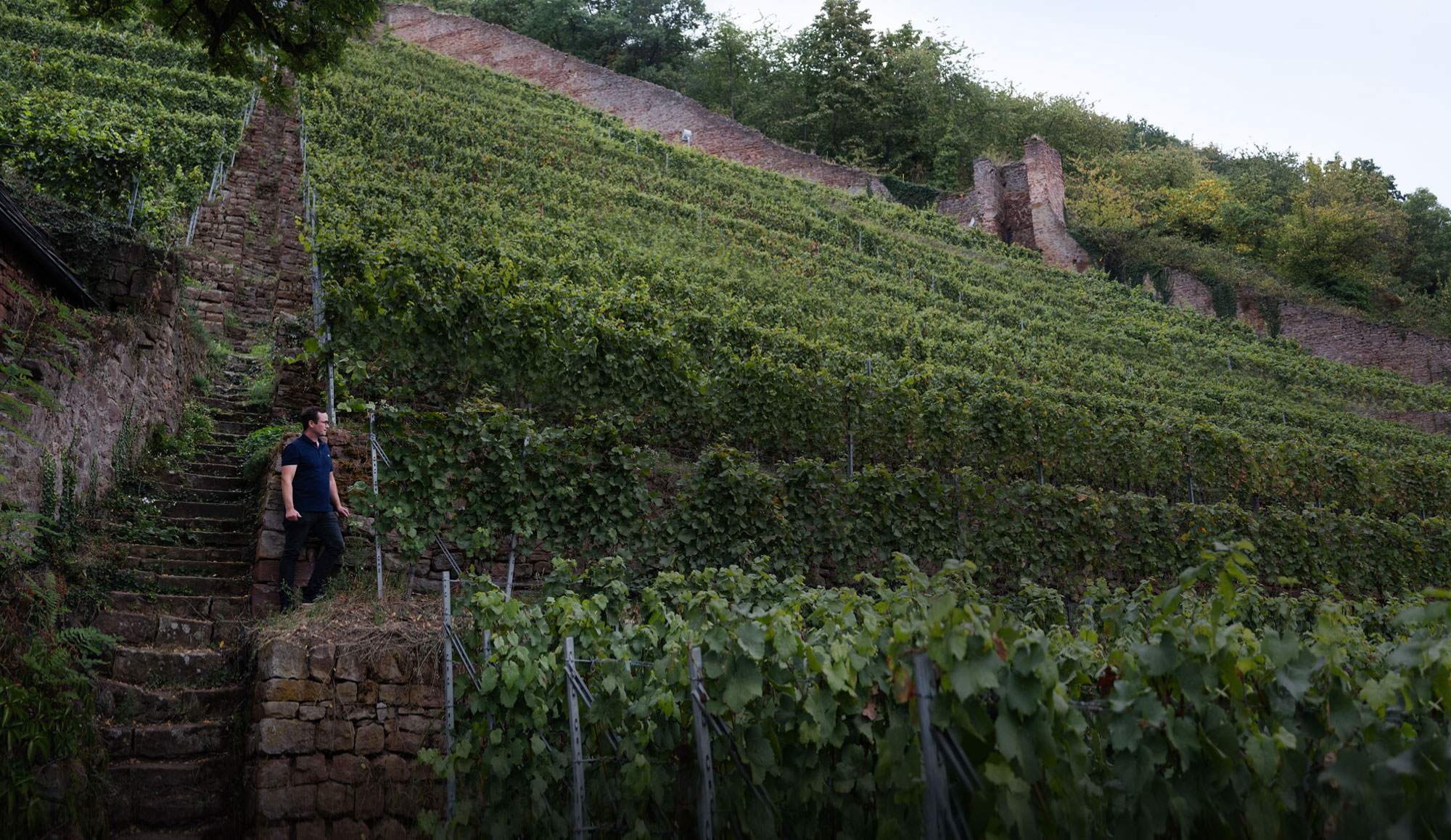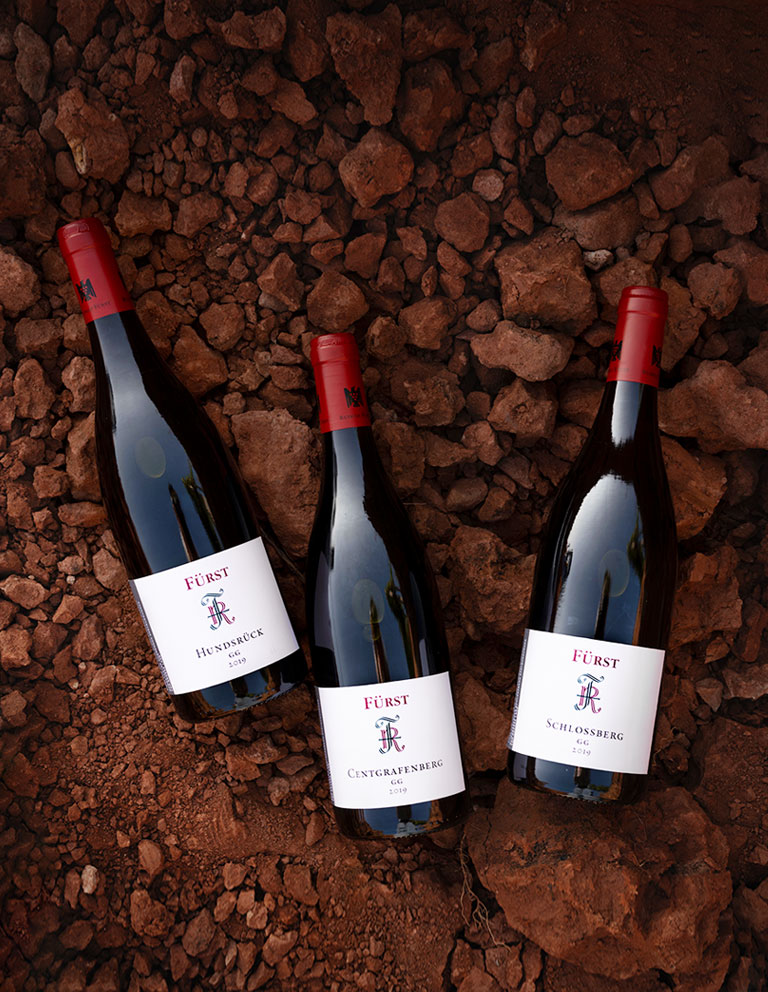
250 million years ago, Franken (Franconia) was close to the equator and the climate was almost desert-like. During this period, the fine quartz grains of the Germanic Basin were covered with a thin layer of iron oxide dust. This haematite led to the formation of Buntsandstein (red sandstone). This ancient rock is the oldest stratum of the Triassic period, which occurred before the formation of the Muschelkalk and Keuper strata. Spätburgunder (Pinot Noir) and Frühburgunder (Pinot Noir Précoce) have long been cultivated in the unique red rock of the Churfranken area of Germany’s Franken wine region southeast from Frankfurt on the Main River.
“Burgundy lies in Bürgstadt,” comments Stephan Reinhardt.

Map geometrician Joseph Mantel, 1792
The importance of viticulture and winemaking increased tremendously in the Electorate of Mainz from the beginning of the 16th century when this region belonged to the Archbishopric of Mainz. Advantageous in this cool climate are the shallow, fine soils with good solar radiation and the heat-retaining capacity of the Main River. The same applies to the dry stone walls that dominate the landscape and bear witness to the unique and impressive cultural achievements of our ancestors.
Hundsrück and Centgrafenberg in the village of Bürgstadt and Schlossberg in Klingenberg are the vineyards that are considered to be the “grand crus” and the heart of Weingut Fürst. Only Spätburgunder (Pinot Noir) is permitted for Hundsrück and Schlossberg in the VDP.GROSSES GEWÄCHS classification from “grand cru” sites, while both Spätburgunder and Riesling are allowed for Centgrafenberg.
Weingut Fürst vinifies Chardonnay of great potential in a Burgundian style in the “grand cru” site Karthäuser in Astheim.

CENTGRAFENBERG
VDP.GROSSE LAGE®
Cool power, iron minerality, elegance and finesse
Centgrafenberg is the timeless, classic “grand cru” vineyard for Spätburgunder (Pinot Noir) – and meanwhile also Riesling. The vineyard has a slope gradient of up to 40 percent.
The soils of Centgrafenberg are comprised of the oldest rock of the Triassic formation, red sandstone, which is characterised here by varying degrees of weathering. The iron-rich subsoil is particularly suitable for growing Burgundian grape varieties.
Weingut Fürst best Riesling parcels are found in the lower part of the partially terraced slope. Worthy of mention about the Centgrafenberg, which is located in the middle of a residential area on the small tributary Erf, is that it was once owned by the Archbishops of Mainz.
Andi Schmitt – Paintings oil on canvas - 2020

SCHLOSSBERG
VDP.GROSSE LAGE®
Vivacious, fine and silky, red cherry
The legend of the great German Pinot vineyard Klingenberg goes back to the Middle Ages. It part of the Archbishopric of Mainz from 1505 onwards. It quickly gained fame and praise far beyond its borders. In 1632, the German composer and organist Erasmus Widmann wrote:
“At Klingenberg on the Main,
at Würzburg on Stein,
at Bacharach on the Rhine
– have I often heard said in my time,
are to be found the very best of wine.”
This vineyard climbs a south-southwest-west facing slope with a gradient of up to 95 percent. The dry stone walls that brace the rocky red terraces of the Schlossberg are listed as a protected historical monument. Three kilometres of these natural stone walls protect 13,000 vines in one vineyard hectare. Use of machines is impossible; excruciating manual labour is a prerequisite.
Weingut Fürst acquired three exceptional vineyard parcels in February 2004. Among them is the core piece of the “grand cru” vineyard Schlossberg located directly below the Clingenburg Castle, enclosed by the five-metre high city wall. It consists largely of old vines and new plantings of densely spaced, old Pinot clones. Hundreds of metres of dry stone walls have been carefully restored.

HUNDSRÜCK
VDP.GROSSE LAGE®
Power and length, aristocratic fragrance, finesse, delicate fruit, wild rose
Documents dating 1525 mention the Hundsrück as the smallest and steepest neighbouring site of the Centgrafenberg. With the official re-inscription of this historical vineyard site in 2010, a valuable piece of wine history was restored.
Hundsrück lies on the east end of the Bürgstadt Berg. It is a convex slope that faces directly south with a 40 percent gradient. The subsoil is comprised of friable, weathered layers of iron-rich red rock. The topsoil is shallow and gravelly. It warms easily, is well aerated and has good drainage.
Old Pinot vines dominate the vineyard and are supplemented by new, densely spaced plantings of up to 17,000 vines per hectare. The Hundsrück is the flagship of Weingut Rudolf Fürst.

KARTHÄUSER
VDP.GROSSE LAGE®
Salt lemon, minerality, hazelnut
This vineyard is named after the Karthause (Carthusian monastery) that was founded in 1409 in the Volkach hamlet of Astheim near Würzburg. Three and a half hectares of this exceptional vineyard has belonged to Weingut Rudolf Fürst since 1999.
Meagre, rocky white shell limestone and terrace gravel characterise the soil. Vines thrust their roots deep in the crevices of this well-drained site in search of nourishment – ideal conditions for Chardonnay.
Although Chardonnay is not yet a classified grape variety for Grosses Gewächs wines from this vineyard, it is certainly in the same league of quality as our Pinot Noir grand cru wines.

BÜRGSTADTER BERG
VDP.ERSTE LAGE®
The “little brother” of Centgrafenberg and Hundsrück
Map geometrician Joseph Mantel, 1792
Numerous historic wine cellars of Bürgstadt testify to the flourishing of viticulture under the dominating influence of the Archbishopric of Mainz from the 16th century onwards.
Nestled in the valley of Miltenberg on the sharp south-west bend of the Main River, the Bürgstadter Berg benefits from a mild, warm microclimate protected by the low mountain ranges of Odenwald and Spessart. The Bürgstadter Berg vineyard includes two “grand cru” sites, the Centgrafenberg and Hundsrück. The wines produced here are never opulent or sumptuous. They are instead characterised by finesse and minerality. These are ideal conditions for our “premier cru” Spätburgunder.
Weingut Rudolf Fürst became a pioneer for the rare Frühburgunder (Pinot Noir Précoce) many years ago. Through the winery’s efforts, this moody, small-berried grape variety has been successfully revived in the region.
Special attention is also given to the cultivation and vinification of Chardonnay and Weissburgunder (Pinot Blanc). The best Weissburgunder wines grow in the eastern part of the Bürgstadter Berg where the soil is richer.
Under the initiative of Paul and Sebastian Fürst, the Bürgstadt winegrowers have succeeded in obtaining the status of an EU protected designation of origin (PDO) for the “Bürgstadter Berg”. This is thus the first PDO vineyard in Germany.

